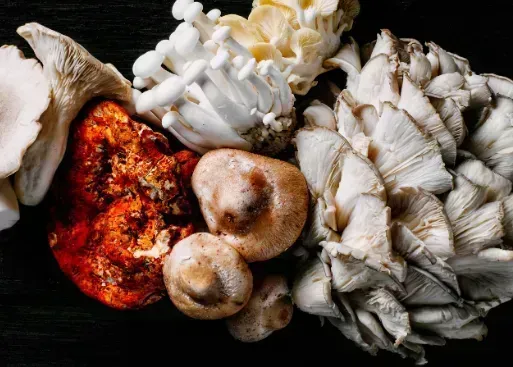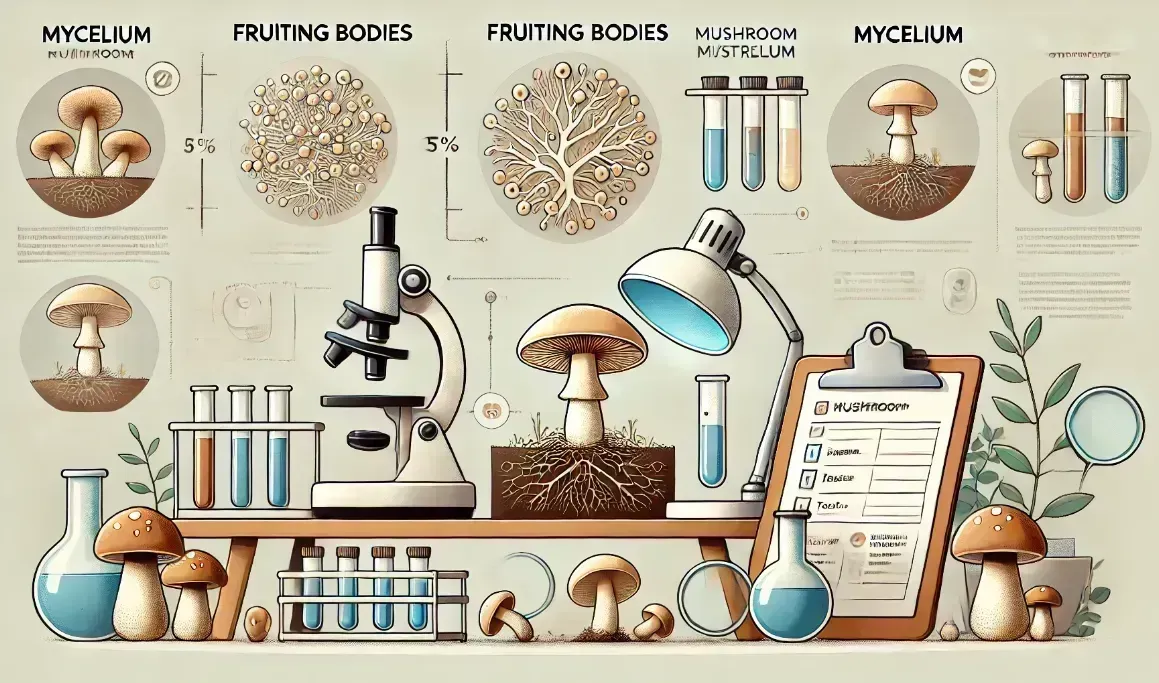Introduction
You are probably here because you heard all of the great stuff about Shiitake mushrooms and want to try to grow your own. They are also relatively easy to grow at home. Fungi Review has closely worked with expert mushroom growers to help deliver this guide. With this knowledge we'll walk you through everything you need to know to successfully grow shiitake mushrooms, whether you're using logs, sawdust, or growing them indoors.
Why Grow Shiitake Mushrooms?
If you haven’t made up your mind on whether to grow shiitake mushrooms or another mushroom, Shiitake mushrooms aren’t just delicious; they’re packed with nutrients, including B vitamins, fiber, and various compounds that boost immunity and heart health. Shiitake can also be a good source of protein for people who minimize animal consumption. Cultivating shiitake mushrooms at home allows you to enjoy fresh, organic shiitake mushrooms with no artificial fillers and save money in the long run.
You can follow the guide here or download the Cheat Sheet.
Step 1: Decide How You Want to Grow Your Shiitake Mushrooms
The first step is to decide on the cultivation method that suits your needs and resources:
- Log Cultivation: Involves inoculating hardwood logs with shiitake mushroom spawn and allowing the mycelium to colonize the wood naturally.
- Indoor Bag Cultivation: This method utilizes sawdust or straw substrate in bags and is typically used in commercial settings due to its faster turnaround time and greater control over environmental conditions.
- Mushroom growing kit: Little setup needed and beginner friendly method, with very limited yields and less control over the process.
The choice between these methods depends on factors like your budget, available space, time commitment, and desired level of control over the growing process.
Pros And Cons Of Different Shiitake Mushroom Growing Methods:
Log Cultivation
|
Pros |
Cons |
|
Long-term production: Shiitake mushroom logs can produce flushes of mushrooms every 4-5 weeks for up to 6-8 years with proper care. |
Long incubation period: Shiitake logs require 6-12+ months for the mycelium to fully colonize the wood before fruiting. |
|
Low maintenance: Once inoculated and placed in a suitable environment, shiitake logs require minimal upkeep, mainly focusing on moisture management. |
Log sourcing can be challenging: Finding suitable hardwood logs free of disease and competing fungi can be difficult. |
|
Natural growing method: Cultivating shiitakes on logs closely mimics their natural growth patterns, providing a sustainable and environmentally friendly approach. |
Susceptible to pests: While shiitakes themselves are relatively pest-free, logs can attract insects and animals like woodpeckers. |
|
Limited control over fruiting: Natural fruiting cycles are influenced by environmental conditions, potentially making it harder to plan harvests. |
Indoor Bag Cultivation (Sawdust/Straw)
Pros |
Cons |
|
Faster turnaround time: Compared to log cultivation, growing shiitakes in bags with sawdust or straw substrate can yield mushrooms in 2-4 months. |
Requires pasteurization/sterilization: The substrate must be treated to eliminate competing organisms, which involves additional time, equipment, and resources. |
|
Greater control over environment: Indoor cultivation allows growers to optimize temperature, humidity, and light conditions for consistent mushroom production. |
Higher maintenance: Indoor cultivation requires regular monitoring and adjustments of environmental conditions, including misting the bags multiple times per day. |
|
Substrate readily available: Unlike sourcing logs, sawdust and straw can be easily purchased or obtained, making this method more accessible. |
Limited number of flushes: Unlike logs, each bag may only produce 5-7 flushes of mushrooms before needing to be replaced. |
Mushroom Growing Kit
|
Pros |
Cons |
|
Beginner friendly: Very easy to get into, needing limited prior knowledge. |
Limited Yield: Mushroom growing kits generally have lower yields compared to other methods. |
|
Convenience: Minimal setup required and are designed to be hassle-free. |
Higher Cost Per Harvest: While growing kits are convenient, they can be more expensive on a per-harvest basis. |
|
Faster Results: Since the substrate is already inoculated with mushrooms spawn, you can see mushrooms growing within a few weeks. |
Less Control: Kits are designed to be ready-to-use, which means you have less control over variables such as spawn quantity. |
|
Space Efficient: Kits are compact, making them ideal for people with limited space. |
Short Lifespan: Most kits are designed to provide only one or two harvests before they expire, meaning they may not last long. |
|
No Need For Specialized Equipment: Unlike traditional mushroom farming, growing kits don't require extra tools. |
In our opinion Log cultivation is the most practical approach for hobbyists and beginners, while the mushroom growing kit is best for people unsure whether they want to commit for a longer period of time. Indoor bag cultivation is typically used in commercial settings due to its faster turnaround time and greater control over production.
Select and Prepare Your Substrate
Log Preparation:
- Choose the Right Log: Select a healthy hardwood log, ideally from species like oak, chestnut, alder, hornbeam, ash, or birch. The log should be free of disease and other fungi. Logs cut during the dormant season (autumn to late winter) are best.
- Ideal Size: A diameter of 20-35 cm and a length of 0.5-1 meter is recommended.
- Rest the Log: After cutting, allow the log to rest for 2 weeks (and no longer than 8 weeks) to let the tree's natural defenses die back. Keep the logs in a shaded area, off the ground, and protected from wind and sun, but allow for natural rainfall.
Bag Cultivation (Sawdust/Straw) Preparation:
- Source Substrate: You can purchase sawdust and straw from suppliers or use your own.
- Pasteurize/Sterilize: Treat the substrate with heat or cold water lime pasteurization to eliminate competing organisms. This step is crucial to prevent contamination and promote healthy shiitake mushroom growth.
Growing Indoors Using a Shiitake Mushroom Kit:
- Buy the equipment: Purchase a mushroom growing kit (usually contains a block of pre-inoculated sawdust or straw), spray bottle, and a humidity tent (optional)
- Inoculate: Since the substrate is already inoculated you can skip the next step.
Inoculate the Substrate
Log Inoculation:
- Choose Spawn: Shiitake spawn is available as plug spawn (dowels) or sawdust spawn.
- Drill Holes: Using a drill bit matching your spawn type (8.5mm for plugs, 12.5mm for sawdust), drill holes 1 inch deep in a diamond pattern every 6 inches along the log, staggering rows for optimal spacing. A 3-8 inch diameter log requires about 50 holes, and larger logs will need more. You can use masking tape on your drill bit to mark the desired depth of your holes.
- Insert Spawn: Gently hammer in plug spawn or use an inoculation tool to pack sawdust spawn into the holes. (make sure it is flush with the log)
- Seal with Wax: Cover each inoculation point with melted cheese wax or plug wax to retain moisture and prevent contamination.
Common Mistakes to Avoid
- Log Drying Out: If your logs dry out too much, they won’t produce mushrooms. If you're in a particularly hot or dry climate, consider using a sprinkler system to keep the logs moist.
- Incorrect Timing: Inoculate your logs in spring or fall. Avoid inoculating
Bag Inoculation:
- Maintain Cleanliness: Ensure a sterile work environment, including disinfected surfaces, sterilized utensils, and thoroughly washed hands.
- Optimal Moisture: Squeeze the substrate; a few drops of water should be released.
- Mix Spawn and Substrate: Combine the shiitake spawn and substrate in a sterilized container, ensuring even distribution.
- Fill and Seal Bags: Transfer the mixture into growing bags and tightly seal them with tape, clips, or rubber bands.
Incubation: The Mycelium Growth Phase
Log Incubation:
- Elevate Logs: Place the inoculated logs on bricks, timber, or pallets to prevent contamination from the ground.
- Shaded and Protected Environment: Keep the logs in a shaded area, protected from direct sunlight and strong winds. Use a breathable covering, like shade netting or mesh tarp, to retain moisture while allowing air circulation.
- Moisture Management: Ensure the logs receive adequate moisture. In dry conditions, water the logs for 10-20 minutes weekly. Avoid watering in freezing temperatures.
Bag Incubation:
- Warm, Dark Environment: Place the inoculated bags in a warm, dark area with consistent temperature (around 70°F). [Information about the ideal temperature for shiitake bag cultivation was not found in the provided sources. 70°F is a common recommendation for many mushroom species, but you may want to verify this information.]
- Monitor Colonization: Shiitake mycelium is brown in color. Full colonization can take 2-4 months.
Mushroom Kit incubation:
- Place in a cool shaded spot: An ideal spot would be on a countertop or shelf in the most humid part of your house. Keep out of direct sunlight and away from drafts or heaters.
- Mist Daily: Spray the substrate with water 1-2 times a day to keep it moist and maintain humidity levels. You can use a humidity tent if you live in a particularly dry climate.
Fruiting: Triggering Mushroom Production
Shiitake mushroom strains can be classified into three primary categories based on their fruiting times:
- Warm weather strains: These shiitake strains typically fruit in the early summer and early fall.
- Cold weather strains: These shiitake strains fruit in the winter.
- Wide range strains: These shiitake strains can fruit throughout the year and are most susceptible to forcing, giving growers more control over production timing.
The source notes that it's important to consider your local climate and the time of year when selecting a shiitake strain for cultivation.
Log Fruiting:
- Shocking/Initiating: To induce fruiting, "shock" the logs by submerging them in cold, clean water for 12-24 hours (longer in colder weather).
- Stacking and Protection: After shocking, stack the logs in an A-frame or lean-to configuration for easy access during harvest. Use a fruiting blanket or row cover to protect the logs from extreme weather and maintain humidity.
- Maintain Ideal Conditions: Keep the fruiting area shaded with good air circulation. Monitor moisture levels and mist the logs if needed. (Good quality logs can fruit for up to eight years)
Bag Fruiting:
- Open Bags and Provide Humidity: Once the substrate is fully colonized, open the bags and place them in a humid environment with good air circulation.
- Misting: Mist the bags several times a day to maintain high humidity levels.
Kit Fruiting
- Misting: Spray the substrate with water 1-2 times a day to keep it moist and maintain humidity levels. You can use a humidity tent if you live in a particularly dry climate.
Harvesting: Picking Your Shiitakes
Log Harvest: It takes about 6-12 months for inoculated shiitake logs to start producing mushrooms. After harvesting, the logs should rest for one to three months before being soaked again.
Bag Harvest: It takes about 7-12 weeks from inoculation to first harvest.
Kit Harvest: Shiitake mushrooms should begin to appear within 1-2 weeks.
Harvest tips:
- Ideal Harvest Stage: Harvest shiitake mushrooms when the caps are about 50-75% open, with edges still slightly curled inwards.
- Harvesting Technique: Gently twist and pull the mushrooms from the substrate or use a sharp knife or scissors to cut the stems close to the surface. Avoid touching the caps to prevent bruising.
Storage and Enjoyment
- Fresh Storage: Store fresh shiitakes in a breathable container in the refrigerator for up to 2-3 weeks.
- Drying for Long-Term Storage: Dry shiitakes by air-drying in sunlight or using a dehydrator or oven on a low setting. Store dried shiitakes in airtight containers in a cool, dark place for up to a year.
- Culinary Uses: Enjoy your fresh or rehydrated shiitake mushrooms in a wide range of dishes, from simple sautés to complex soups, stir-fries, and even ramen!
Where To Buy Mushroom Kits?
If you are considering to buy a Shiitake mushroom kit here are some brands to consider:
1. Root Mushroom Farm Shiitake Mushroom Growing Kit
- Description: A user-friendly kit that includes a pre-inoculated log, this is ideal for first-time growers. It comes with detailed instructions and typically fruits within two weeks.
- Pros: Easy to use, high yield, reusable for multiple harvests.
- Price: Around $25-$35
2. Back to the Roots Organic Mushroom Growing Kit
- Description: While not specific to shiitake, this kit allows you to grow several types of mushrooms, including shiitake. It’s compact and suitable for indoor growing.
- Pros: Organic, beginner-friendly, eco-friendly packaging.
- Price: Around $20-$30
3. North Spore Shiitake Mushroom Kit
- Description: This kit includes a block of shiitake mushroom mycelium ready for fruiting. It’s designed for indoor growing and provides a reliable harvest.
- Pros: High-quality spawn, detailed instructions, great for those with limited space.
- Price: Around $30-$40
Extra Considerations and Definitions
Types of spawn
If you are a complete novice some of these terms may be new to you, so we are here to break it down.
So Plug spawn and sawdust spawn are two ways to introduce shiitake mycelium to a growing medium, typically logs.
Plug spawn generally takes longer to fruit than sawdust spawn. Logs inoculated with sawdust spawn will begin to produce mushrooms in 6-12 months, while logs inoculated with plug spawn will fruit in 12-24 months.
Pinning: The First Stage of Shiitake Mushroom Fruiting
"Pinning" refers to the initial stage of mushroom development, specifically the formation of tiny, primordial mushroom structures called pins. These pins emerge from the substrate (logs or sawdust blocks) and represent the beginning of the fruiting process, marking the transition from the mycelial growth phase to the actual mushroom formation phase.
Think of pinning as the shiitake mycelium "putting out feelers" to test the environmental conditions and determine if they are suitable for fruiting. [This is an analogy, not a statement from the provided sources.] If the conditions are right, the pins will continue to develop, eventually growing into mature shiitake mushrooms.
Triggering Pinning:
Shiitake pinning is typically triggered by changes in temperature and moisture, which signal to the fungus that it's time to reproduce. This often happens naturally when conditions fluctuate, such as after a rainfall followed by a period of warmer temperatures. Growers can also induce pinning through a process called "shocking" or "forced fruiting".
Shocking Shiitake Logs: A Technique for Induced Fruiting
"Shocking," also known as "forced fruiting" or "initiating," is a technique used in shiitake mushroom cultivation to stimulate the logs into producing mushrooms on a schedule determined by the grower. This method involves briefly exposing the logs to a sudden change in temperature and moisture to mimic natural conditions that trigger fruiting.
Here are some environmental factors that can negatively affect shiitake mushroom pinning:
- Temperature Fluctuations: While the ideal temperature range for shiitake pinning is between 55–65°F, sudden temperature changes, especially cold temperatures, can inhibit mushroom growth. Cold winds can also dry out the delicate pins, preventing them from developing further.
- Inadequate Humidity: Shiitake mushrooms require high humidity (at least 85%) for pinning. If the humidity levels drop too low, the pins can dry out and fail to develop.
- Excess Moisture: While humidity is crucial, excessive moisture, especially from rain, can negatively impact shiitake pinning. The mushrooms can absorb too much water, becoming waterlogged and reducing their quality. This can also lead to problems like mold growth and bacterial contamination.
- Poor Air Circulation: Stagnant air can create a favorable environment for mold and other contaminants to thrive, potentially harming the developing mushrooms. While maintaining humidity is important, good air circulation is also necessary for healthy pinning. The sources recommend using breathable coverings during incubation and removing them during fruiting to allow for adequate airflow around the logs.
- Insufficient Light: Although shiitake mycelium can grow in darkness, light is essential for fruiting. If the logs are kept in complete darkness during the pinning stage, mushroom development will be hindered. The sources recommend providing enough light to read a newspaper at arm's length for optimal fruiting.
- Pests and Animals: While shiitake mushrooms themselves are relatively pest-free, the logs can attract insects and animals that can damage the developing pins. For example, snails and slugs can feed on the mushrooms, and woodpeckers have been known to peck at logs and remove the spawn. Protecting the logs with netting or other barriers can help prevent damage from pests and animals.
- Competition From Other Fungi: If the logs are not properly prepared and sterilized or if the growing environment is not clean, other fungi and microorganisms can outcompete the shiitake mycelium, potentially inhibiting pinning and fruiting.
Conclusion
Fungi Review believes that growing shiitake mushrooms can be a rewarding and delicious experience. By understanding the different cultivation methods, the steps involved, and the ideal environmental conditions for each stage of growth, you can successfully cultivate your own shiitakes and enjoy the fruits of your labor. Remember to be patient, attentive, and adapt your approach based on your specific growing conditions and chosen method.
Be sure to check out our other blogs for more guides and info on the world of mushrooms!





